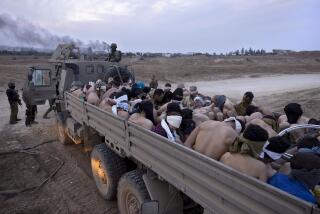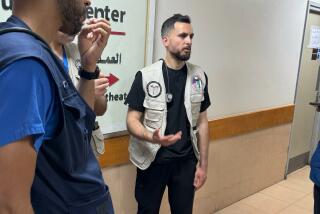Sacred surprise behind Israeli hospital
- Share via
JERUSALEM — The city of Ashkelon has been in the headlines lately, and not for its pretty beaches. The city of 110,000 has sadly joined Israel’s southern front line as rockets fired from the Gaza Strip improve in range and technology.
Last week, a rocket hit a shopping mall in town; the dozens of injured were treated at the city’s Barzilai Medical Center.
It turns out the hospital grounds contain an interesting bit of history: a site holy to certain Shiite Muslims, thousands of whom have come to pray there over the years. Ashkelon has 5,000 years of recorded history, but when the hospital was first built in 1961, nothing indicated that the hill out back was anything special.
The consecration of the site dates back to the early days of Islam. The decades that followed the death of the prophet Muhammad in 632 were marked by a bitter and bloody dispute over succession, a conflict that ultimately marked the split between Sunni and Shiite Muslims.
In a nutshell, Ali, Muhammad’s cousin and son-in-law, was passed over for the position of caliph -- leader of the young Muslim nation. Ali’s followers eventually rebelled, touching off years of conflict.
After Ali was assassinated in 661, his sons Hasan and Hussein carried on his struggle. Hussein and his small rebel army were slaughtered in 680 in what is now the Iraqi holy city of Karbala. His head was delivered as a trophy to Yazid, the victorious caliph, in Damascus, while his body remained in Karbala. Shiites commemorate Hussein’s death annually in the intense day of mourning known as Ashura.
Both Karbala and Damascus became sites of Shiite pilgrimages. Sunni rulers, displeased with the phenomenon, decided to relocate Hussein’s head to the far edge of the kingdom -- Ashkelon. It remained there for several centuries, until the legendary Muslim leader Saladin sent the head to Egypt for safekeeping from the invading Crusaders.
What was once the far end of an ancient Muslim kingdom is now a grassy mound behind an Israeli hospital.
A millennium after Hussein’s head was removed from Ashkelon, the site is still revered by Shiite offshoots, mostly from India and Pakistan. The pilgrims include those from countries with no diplomatic ties with Israel, hospital officials say.
About a decade ago, a Shiite spiritual leader arrived at the hospital with an unusual request: to be allowed to erect a prayer area for the pilgrims.
“How do you know this is the site?” asked Dr. Ron Lobel, deputy director of the medical center.
“I walked out to the mound with him,” Lobel said. “He took out a shovel and started digging. To my astonishment, a meter or so deep, he exposed the cornerstone of the ancient mosque that had been built where the head had been buried, and was later destroyed by the Crusaders.”
With the hospital’s blessing, the worshipers imported the most valued marble in India. The prayer area, built seven or eight years ago, is open to the pilgrims.
“They are quiet, peaceful people. They come in silence, sometimes barely uttering a sound,” said Lobel, who has become the resident expert on the subject. “An island of Shiite Muslim prayer in an Israeli hospital in a Jewish state. It really is unique.”
More to Read
Sign up for Essential California
The most important California stories and recommendations in your inbox every morning.
You may occasionally receive promotional content from the Los Angeles Times.










